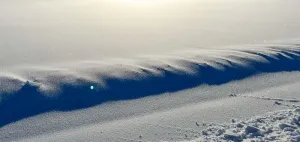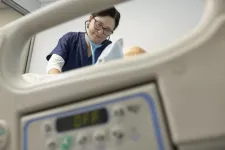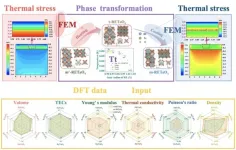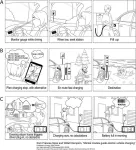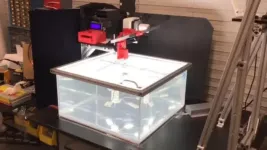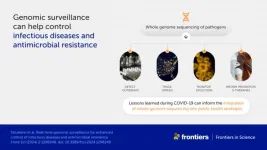(Press-News.org) One might think that snow, of all things, is easy to describe: it is cold, white and covers the landscape like a blanket. What else is there to say about it?
A lot, according to Mathieu Nguyen. He has just defended his doctoral thesis on the optical properties of snow at the Norwegian University of Science and Technology (NTNU) in Gjøvik.
“Snow reflects all wavelengths of light and can have very different colours depending on the conditions and the angle at which light hits it. The age and density of the snow and air pollution also affect what it looks like. Snow’s appearance is a very complicated matter,” says Nguyen.
He has analysed over a thousand images of snow. “This type of method can be used in a number of sensor technologies that include everything from giving us a better decision-making basis for when roads should be cleared to monitoring the risk of an avalanche in the mountains more closely.”
A landscape of mirrors
Among other things, Nguyen has studied how snow absorbs and reflects light, and the way the sun makes snow crystals sparkle has been of particular interest.
He believes the beautiful appearance of winter landscapes may hold the key to answering a number of questions that have puzzled researchers for many years.
But first, what is it that makes the snow sparkle on bright sunny days?
“Snow is an accumulation of ice crystals. When conditions are just right, they act like tiny mirrors. If they are at the right angle, they reflect the sunlight directly towards you and shine like ‘sparks’ in the landscape,” says Nguyen.
Huge potential
Many studies have been conducted on how different metals sparkle in this way, but the sparkle in snow is still poorly understood.
“If we are to have fully autonomous cars here in Norway, this type of technology will also contribute to safer travel on winter roads,” says Nguyen.
Nguyen has therefore sought to find out how these sparkles vary in contrast and density in images of snow in different conditions. He hopes it will provide an analysis method that enables us to classify different types of snow from images.
This is not currently possible.
“This type of method can be used in a number of sensor technologies that include everything from giving us a better decision-making basis for when roads should be cleared to monitoring the risk of an avalanche in the mountains more closely. If we are to have fully autonomous cars here in Norway, this type of technology will also contribute to safer travel on winter roads,” says Nguyen.
Requires images from all over the world
So far, the researchers have only collected data from various places in eastern Norway. The results are promising and show that sparkling can be used to classify the grain size of the snow.
However, being able to classify the type of snow more precisely requires a far larger volume of data than they have worked on so far. Preferably with images from all over the world.
“It will be important to get images from other places where the environment is different. Understanding how different levels of pollution play a role in the appearance and properties of snow will be crucial,” says Nguyen.
An experience for the future
In addition to being difficult to interpret from images, snow has long proved surprisingly challenging to reproduce digitally.
“The artificial representations we have of snow in computer games and simulators today are not much better than white surfaces,” says Nguyen.
His findings have also shown promising results in this area. He believes his work will provide people who do not have access to snow with good winter experiences – also in a future where there might be a lot less snow.
According to the Norwegian Meteorological Institute, more than one million Norwegians in 2050 will live in places where there is less than one month of winter conditions. In addition, a recent study in the journal Nature confirmed that the entire Northern Hemisphere is facing a future with less snow as a result of anthropogenic climate change.
“If we are to teach someone who may never have seen snow before what it is, we must be able to reproduce it in all its complexity,” says Nguyen.
References: Mathieu Nguyen, Jean-Baptiste Thomas, and Ivar Farup. Exploring Imaging Methods for In Situ Measurements of the Visual Appearance of Snow Geosciences 2024 14, no. 2: 35. https://doi.org/10.3390/geosciences14020035
Mathieu Nguyen, Jean-Baptiste Thomas, Ivar Farup. (2022). Statistical Analysis of Sparkle in Snow Images Journal of Imaging Science and Technology, pp 050404-1 - 050404-11. https://doi.org/10.2352/J.ImagingSci.Technol.2022.66.5.050404
END
Spring snow, sparkling in the sun, can reveal more than just good skiing conditions
The optical properties of snow could hold the key to everything from better snow plowing to improved avalanche safety
2024-04-25
ELSE PRESS RELEASES FROM THIS DATE:
Using AI to improve diagnosis of rare genetic disorders
2024-04-25
HOUSTON – (April 25, 2024) – Diagnosing rare Mendelian disorders is a labor-intensive task, even for experienced geneticists. Investigators at Baylor College of Medicine are trying to make the process more efficient using artificial intelligence. The team developed a machine learning system called AI-MARRVEL (AIM) to help prioritize potentially causative variants for Mendelian disorders. The study is published today in NEJM AI.
Researchers from the Baylor Genetics clinical diagnostic laboratory noted that AIM's module can contribute to predictions ...
Study unveils balance of AI and preserving humanity in health care
2024-04-25
Cross Country Healthcare, Inc. (NASDAQ: CCRN), a pioneering force in tech-driven workforce solutions and advisory services, in collaboration with Florida Atlantic University's Christine E. Lynn College of Nursing, released its latest research findings in the fourth annual installment of the Future of Nursing Survey: “Embracing Technology While Preserving Humanity.” Drawing insights from more than 1,100 nursing professionals and students, the study illuminates the intricate interplay between cutting-edge health care technologies and the enduring essence of compassionate care.
Survey results reveal a nuanced perspective among nurses toward the integration of Artificial ...
Capturing and visualizing the phase transition mediated thermal stress of thermal barrier coating materials via a cross-scale integrated computational approach
2024-04-25
Thermal barrier coatings (TBCs) are widely used in gas turbine engines to obtain elevated working temperatures and improve engine efficiency. The phase transition of the ceramic layer is accompanied by a large volume difference, causing the concentration of thermal stress, eventually leading to TBCs to fall off and fail. Therefore, it is necessary to quantitatively evaluate the magnitude and distribution of thermal stress induced by phase transition in the ceramic layer.
A team of material scientists led ...
Study reveals emotional turmoil experienced after dog-theft is like that of a caregiver losing a child
2024-04-25
A new study published in the journal Animal-Human Interactions reveals that emotional turmoil experienced by dog owners after their pet has been stolen is like that of losing a loved one such as a caregiver losing their child.
The findings empirically support the notions that the ‘owner’ or guardian roles and relationships equate to familial relationships and, when faced with the theft of their pet, owners feel a similar sense of disenfranchised grief and ambiguous loss.
In the study, some participants felt the loss was more intense ...
PhRMA Foundation awards $1M for equity-focused research on digital health tools
2024-04-25
The PhRMA Foundation (PhF) awarded $500,000 grants to David G. Armstrong, DPM, MD, PhD, of the University of Southern California and Nino Isakadze, MD, MHS, of Johns Hopkins University to conduct research using digital health technologies (DHTs) to improve health equity and health outcomes for patients.
Armstrong and Isakadze were selected out of a group of seven researchers awarded $25,000 planning grants in 2023 by the Foundation to develop comprehensive research proposals to study the use of DHTs for advancing patient health, especially in underserved populations.
“Digital ...
Women with heart disease are less likely to receive life-saving drugs than men
2024-04-25
Athens, Greece – 25 April 2024: Women with heart disease are less often treated with cholesterol-lowering drugs than men, according to research presented today at ESC Preventive Cardiology 2024, a scientific congress of the European Society of Cardiology (ESC).1
“Cholesterol-lowering drugs save lives and prevent heart attacks, and should be prescribed to all patients with coronary artery disease,” said study author Dr. Nina Johnston of Uppsala University, Sweden. “Unfortunately, our study shows that women are missing out on these essential medications.”
Patients with ...
How electric vehicle drivers can escape range anxiety
2024-04-25
Two of the biggest challenges faced by new and potential electric vehicle (EV) drivers are range anxiety and speed of charging, but these shouldn’t have to be challenges at all. That is according to a study by Chalmers University of Technology, Sweden, and the University of Delaware, USA. Researchers discovered that a change in refuelling mindset, rather than improving the size or performance of the battery, could be the answer to these concerns.
The transition from filling up at a petrol station to recharging your electric vehicle in the most convenient location for you, requires a whole new way ...
How do birds flock? Researchers do the math to reveal previously unknown aerodynamic phenomenon
2024-04-25
In looking up at the sky during these early weeks of spring, you may very well see a flock of birds moving in unison as they migrate north. But how do these creatures fly in such a coordinated and seemingly effortless fashion?
Part of the answer lies in precise, and previously unknown, aerodynamic interactions, reports a team of mathematicians in a newly published study. Its breakthrough broadens our understanding of wildlife, including fish, who move in schools, and could have applications in transportation and energy.
“This area of research is important since animals are known to take advantage of the flows, such as of air or water, left by other members of ...
Experts call for global genetic warning system to combat the next pandemic and antimicrobial resistance
2024-04-25
The Covid-19 pandemic turned the world upside down. In fighting it, one of our most important weapons was genomic surveillance, based on whole genome sequencing, which collects all the genetic data of a given microorganism. This powerful technology tracked the spread and evolution of the virus, helping to guide public health responses and the development of vaccines and treatments.
But genomic surveillance could do much more to reduce the toll of disease and death worldwide than just protect us from Covid-19. Writing in Frontiers in Science, an international collective of clinical and public health microbiologists ...
Genetic variations may predispose people to Parkinson’s disease following long-term pesticide exposure, study finds
2024-04-25
A new UCLA Health study found certain genetic variants could help explain how long-term pesticide exposure could increase the risk of Parkinson’s disease.
While decades of research have linked pesticide exposure and Parkinson’s disease risk, researchers have sought to explain why some individuals with high exposure develop the disease while others do not.
One longstanding hypothesis has been that susceptibility to the disease is a combination of both environmental and genetic factors.
The new study, published in the journal NPJ Parkinson’s Disease, used genetic data from nearly 800 Central Valley (California) residents with Parkinson’s ...
LAST 30 PRESS RELEASES:
University of Oklahoma researcher awarded funding to pursue AI-powered material design
Exploring how the visual system recovers following injury
Support for parents with infants at pediatric check-ups leads to better reading and math skills in elementary school
Kids’ behavioral health is a growing share of family health costs
Day & night: Cancer disrupts the brain’s natural rhythm
COVID-19 vaccination significantly reduces risk to pregnant women and baby
The role of vaccination in maternal and perinatal outcomes associated with COVID-19 in pregnancy
Mayo Clinic smartwatch system helps parents shorten and defuse children's severe tantrums early
Behavioral health spending spikes to 40% of all children’s health expenditures, nearly doubling in a decade
Digital cognitive behavioral treatment for generalized anxiety disorder
Expenditures for pediatric behavioral health care over time and estimated family financial burden
Air conditioning in nursing homes and mortality during extreme heat
The Alps to lose a record number of glaciers in the next decade
What makes a good proton conductor?
New science reporting guide published for journalists in Bulgaria
New international study reveals major survival gaps among children with cancer
New science reporting guide published for journalists in Turkey
Scientists develop a smarter mRNA therapy that knows which cells to target
Neuroanatomy-informed brain–machine hybrid intelligence for robust acoustic target detection
Eight SwRI hydrogen projects funded by ENERGYWERX
The Lundquist Institute and its start-up company Vitalex Biosciences Announces Strategic Advancement of Second-Generation fungal Vaccine VXV-01 through Phase 1 Trials under $40 Million Competitive Con
Fine particles in pollution are associated with early signs of autoimmune disease
Review article | Towards a Global Ground-Based Earth Observatory (GGBEO): Leveraging existing systems and networks
Penn and UMich create world’s smallest programmable, autonomous robots
Cleveland researchers launch first major study to address ‘hidden performance killer’ in athletes
To connect across politics, try saying what you oppose
Modulating key interaction prevents virus from entering cells
Project explores barriers to NHS career progression facing international medical graduates
Jeonbuk National University researchers explore the impact of different seasonings on the flavor perception of Doenjang soup
Two Keck Medicine of USC Hospitals named Leapfrog Top Teaching Hospitals
[Press-News.org] Spring snow, sparkling in the sun, can reveal more than just good skiing conditionsThe optical properties of snow could hold the key to everything from better snow plowing to improved avalanche safety
